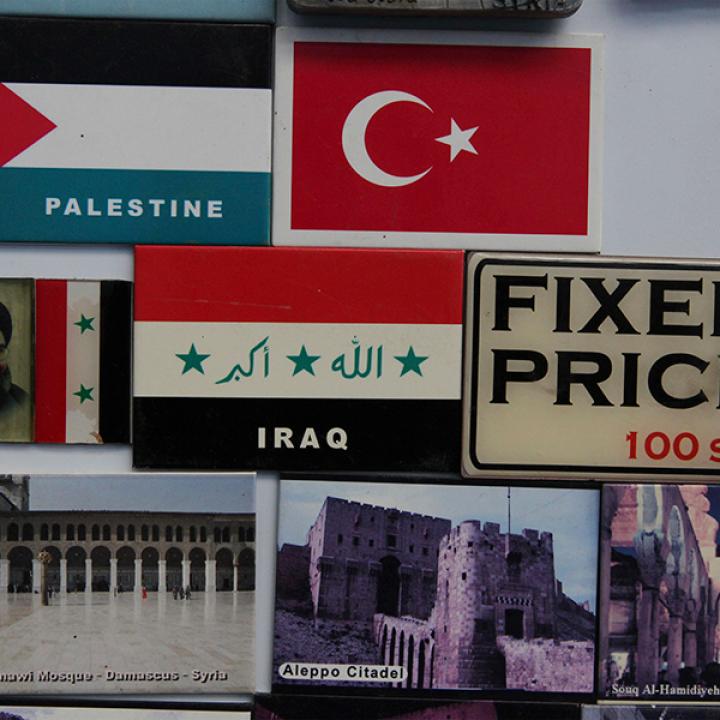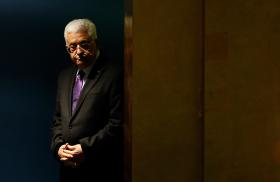
- Policy Analysis
- PolicyWatch 2081
Sworn Frenemies: Sunni-Shiite Conflict and Cooperation

Notwithstanding current hostilities, there is a long history of cooperation between Sunni and Shiite extremists.
In a speech earlier this week, Hassan Nasrallah, leader of the Lebanese Shiite group Hezbollah, described the Sunni organization al-Qaeda as part of a U.S.-led "axis" in Syria. Over the past two years, Syria has become a sectarian battleground pitting the majority Sunni population -- along with hundreds of regional jihadists and Sunni-ruled Saudi Arabia and Qatar -- against the nominally Shiite Alawite regime of Bashar al-Assad and its Shiite backers Iran and Hezbollah. Meanwhile, Riyadh is rounding up Shiite clerics in the kingdom's Eastern Province on charges of spying for Iran. In Jordan, King Abdullah has predicted that "prolonged sectarian conflict" in Syria will have "disastrous consequences on the region for generations to come." And in April, a Brookings Institution study argued that sectarianism is supplanting the Arab-Israeli conflict as the preeminent mobilizing issue for Arabs.
Indeed, the defining characteristic of the Arab awakening since 2011 may be the resurgence of Sunni-Shiite tensions in the Middle East. The two branches of Islam have been battling for political and religious primacy since the seventh century, and today, Muslim on Muslim violence is spiking from Syria to Iraq, Bahrain, Saudi Arabia, Pakistan, and elsewhere. Yet despite deep animosities, conflicts, and competitions, Sunnis and Shiites have frequently demonstrated an ability to cooperate, particularly against the United States and its regional allies.
ISLAMIST COOPERATION
In recent years, Sunni and Shiite Islamists and governments have found common cause on several occasions.
Iran and al-Qaeda. A decade ago, Sunni and Shiite extremists actively worked together to target the United States. Several of the nineteen September 11 hijackers transited through Iran en route to America, and later -- even as Sunni al-Qaeda was cleansing "infidel" Shiites in Iraq -- Tehran provided sanctuary for hundreds of the organization's operatives and leaders. These ties proved critical in helping Iran undermine the U.S. occupation in neighboring Iraq. Similarly, Tehran established a relationship with the Sunni Taliban in Afghanistan to subvert American postwar stabilization efforts.
Hamas and Iran. Radical Sunni and Shiite actors have also forged alliances against Israel. Overriding hostility toward the Jewish state has brought Shiite Iran and the Sunni terrorist organization Hamas together for years, with Tehran providing training, logistical support, and hundreds of millions of dollars to the Palestinian group since at least 1995. To be sure, relations between the two have shown signs of strain lately. In 2011, Hamas evacuated its offices in Damascus to protest the Iranian-backed Assad regime's killing of thousands of mostly Sunni Syrians. Yet given their mutual, enduring antipathy toward Israel, this fracture might prove only temporary.
Indeed, only a year prior to the outbreak of hostilities in Syria, intellectuals from Hamas -- essentially the Palestinian chapter of the Muslim Brotherhood -- embarked on an effort to surmount the ideological barriers impeding Sunni-Shiite ties. In 2010, Hamas foreign minister Ahmed Yousef penned and distributed a booklet titled "The Muslim Brotherhood and the Islamic Revolution in Iran," which sought to reconcile the visions of Brotherhood founder Hassan al-Banna and Ayatollah Ruhollah Khomeini, the leader of Iran's 1979 revolt. The treatise highlighted Tehran and the Brotherhood's mutual admiration for the architect of the modern jihadist movement, Sayyed Qutb, as well as their common goal of establishing a supra-Islamic state based on sharia. "There is no escape from overcoming the conflicts between Sunnis and Shiites," Yousef wrote; "these conflicts do not amount to a religious contradiction."
Egypt and Iran. Yousef's message has not been lost on Egyptian president Muhammad Morsi and his Muslim Brotherhood administration. Despite the longstanding Egyptian-Iranian cold war -- which dates back to Cairo's 1979 peace treaty with Israel, followed by Tehran's celebration when peacemaker president Anwar Sadat was assassinated two years later -- Morsi's chose Iran for his second visit to a non-Arab country. He was not particularly solicitous of his Shiite hosts; the ostensible purpose of the quick August 2012 trip was for Morsi to hand over the presidency of the Non-Aligned Movement to Iranian president Mahmoud Ahmadinejad. Yet the message of the visit was the visit itself. As Morsi advisor Gehad al-Haddad later stated, Egypt under the Muslim Brotherhood would be "building new relations and defining new rules" with Iran.
Egypt and Hezbollah. This tack also applies to Lebanon's Shiite militia Hezbollah, established by Iran in the early 1980s. In recent years, the group has been implicated in sectarian violence such as the 2005 assassination of Lebanese Sunni leader Rafiq Hariri, and forty-nine of its operatives were arrested in the Sinai in late 2008. Nevertheless, Morsi has reversed Egypt's longstanding policy and is working to establish "a relationship" with the militia, according to Cairo's envoy in Beirut.
In the Brotherhood's eyes, Hezbollah's commitment to confronting Israel has long placed the group in a unique category of Shiites. In 2006, when Hezbollah attacked Israel during the latter's incursion into Gaza, Brotherhood general guide Muhammad Mahdi Akef offered to deploy fighters alongside the militia in Lebanon. And in 2009, a few months after Hezbollah operatives were apprehended on Egyptian territory smuggling weapons to Hamas, Akef publicly praised group leader Hassan Nasrallah for "support[ing] the resistance...and help[ing] the Palestinians."
Still, ancient grudges die hard. When Iran's President Ahmadinejad visited Cairo in February, he was greeted by shoe-throwing protestors enraged by Tehran's unwavering support for the Assad regime. Then, during a meeting at the preeminent Sunni seminary al-Azhar, clerics publicly criticized Iran for meddling in Bahrain and encouraging Shiite proselytizing in Egypt. More recently, on March 15, Egyptian Salafists held a large demonstration in Tahrir Square denouncing "normalization" with Iran and Shia Islam, and threatening to "escalate the matter" if the Brotherhood persisted in developing the relationship.
It is unclear whether Morsi's outreach to Iran has been motivated by anti-Israeli sentiment or other factors. Like his visit to China, it could represent a desire to diversify sources of foreign assistance by distancing Egypt from its three-decade strategic alliance with Washington.
IRAN'S ENDURING INTERESTS
Although anti-American/Israeli ideology has historically provided much of the impetus for cooperation between Sunni and Shiite fundamentalists, an equally important driver has been -- and will continue to be -- good old-fashioned pragmatism. For Tehran in particular, cultivating Sunnis is both a strategic hedge and a vehicle for promoting Islamic revolution.
Consider that during the Iran-Iraq War in the 1980s -- a time when Iran was forming Hizballah amid growing regional Sunni-Shiite tensions -- Tehran also supported the Lebanese Sunni militia Harakat al-Tawhid al-Islami. That decision was spurred in part by a clear coincidence of interest: based in the Sunni stronghold of Tripoli, the militia sought to unify Sunnis and Shiites with an eye toward reestablishing the type of supra-Islamic state that ended with the fall of the Ottoman Empire. At the same time, Tehran hoped to broaden its client network in Lebanon beyond Shiites.
Iranian domestic concerns are a factor as well. Today, Sunnis comprise 10 percent of the country's population and are the fastest-growing constituency in Iran, bearing an estimated seven children per family compared to the Shiite average of less than two. The regime no doubt views Iranian Sunnis as a long-term demographic threat, one it may have to proactively counter via a grand sectarian reconciliation. Yet any such outreach efforts are currently focused abroad rather than inside Iran, where Sunnis are still viewed with suspicion and derision (e.g., the nearly two million Sunnis in Tehran do not have a single mosque of their own).
CONCLUSION
Even as sectarian conflict peaks, many Islamists in the Middle East are focused on sublimating denominational differences to achieve the elusive goal of reestablishing a supra-Islamic state. Considerable obstacles to realizing this dream remain, including the burgeoning radical Salafist movement and the question of whether Sunni or Shiite jurisprudence would ultimately preside in such a state. In any event, the chances of a historic Sunni-Shiite reunion emerging in the near term are remote given current regional dynamics.
Determined to rebalance U.S. policy toward Asia, the Obama administration will likely choose to watch the Sunni-Shiite deterioration from a distance. But Washington should not be surprised if hostile factions among these sworn frenemies find enough common ground to once again challenge U.S. interests in the Middle East. As the Arab proverb goes -- and historical precedent suggests -- when it comes to Sunni-Shiite relations, it's "me against my brothers...me and my brothers and cousins against the stranger."
David Schenker is the Aufzien fellow and director of the Program on Arab Politics at The Washington Institute.



